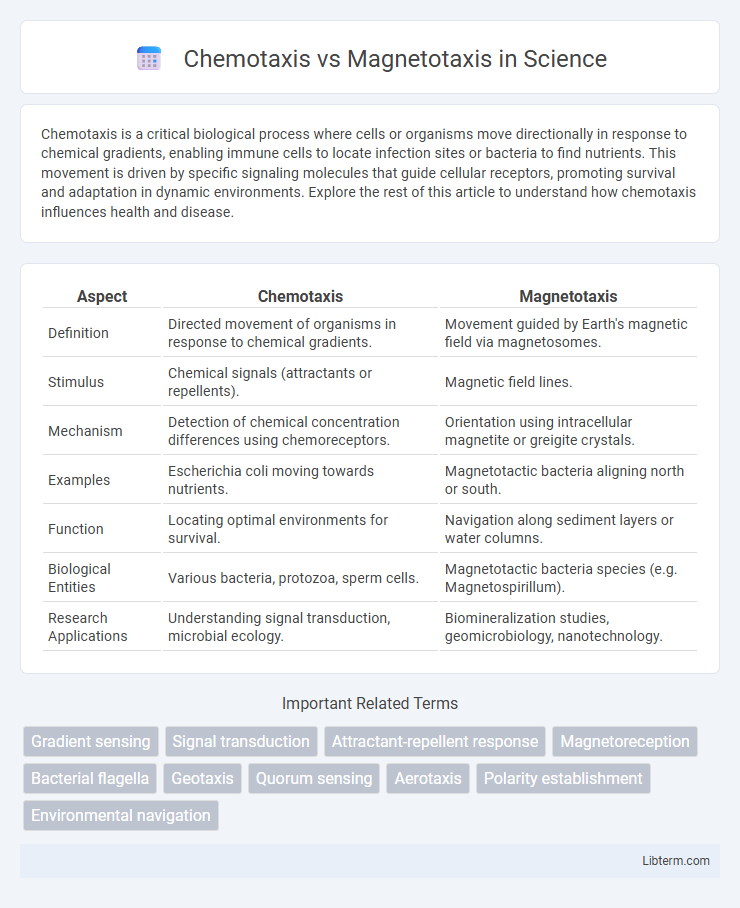Chemotaxis is a critical biological process where cells or organisms move directionally in response to chemical gradients, enabling immune cells to locate infection sites or bacteria to find nutrients. This movement is driven by specific signaling molecules that guide cellular receptors, promoting survival and adaptation in dynamic environments. Explore the rest of this article to understand how chemotaxis influences health and disease.
Table of Comparison
| Aspect | Chemotaxis | Magnetotaxis |
|---|---|---|
| Definition | Directed movement of organisms in response to chemical gradients. | Movement guided by Earth's magnetic field via magnetosomes. |
| Stimulus | Chemical signals (attractants or repellents). | Magnetic field lines. |
| Mechanism | Detection of chemical concentration differences using chemoreceptors. | Orientation using intracellular magnetite or greigite crystals. |
| Examples | Escherichia coli moving towards nutrients. | Magnetotactic bacteria aligning north or south. |
| Function | Locating optimal environments for survival. | Navigation along sediment layers or water columns. |
| Biological Entities | Various bacteria, protozoa, sperm cells. | Magnetotactic bacteria species (e.g. Magnetospirillum). |
| Research Applications | Understanding signal transduction, microbial ecology. | Biomineralization studies, geomicrobiology, nanotechnology. |
Introduction to Taxis: Navigating Biological Environments
Chemotaxis and magnetotaxis are two distinct forms of taxis that enable microorganisms to navigate their environments by responding to specific stimuli. Chemotaxis involves movement toward or away from chemical gradients, allowing organisms to find nutrients or avoid harmful substances, while magnetotaxis involves orientation and movement along magnetic field lines, aiding bacteria in locating optimal oxygen concentrations in sediment layers. Understanding these taxis mechanisms reveals how microorganisms adapt and survive by interacting precisely with their surroundings through sensory and motor responses.
Defining Chemotaxis: Sensing and Moving Toward Chemicals
Chemotaxis is the biological process by which cells or organisms detect chemical gradients in their environment and move directionally toward higher concentrations of attractant molecules or away from repellents. This sensory mechanism relies on membrane-bound receptors that recognize specific chemicals, triggering intracellular signaling pathways that regulate flagellar or ciliary motion. In contrast to magnetotaxis, which orients movement according to Earth's magnetic field, chemotaxis enables organisms to locate nutrients or avoid harmful substances through chemical cue detection.
Magnetotaxis Explained: Aligning with Earth’s Magnetic Field
Magnetotaxis is a behavior exhibited by magnetotactic bacteria that enables them to align and navigate along Earth's magnetic field lines using intracellular magnetite or greigite crystals called magnetosomes. This biological process allows these microorganisms to efficiently locate optimal oxygen concentrations in aquatic environments by moving along geomagnetic field vectors, contrasting chemotaxis, which relies on chemical gradients for movement. Understanding magnetotaxis provides insights into microbial navigation, biogeochemical cycling, and potential applications in biotechnology and nanomedicine.
Molecular Mechanisms Behind Chemotaxis
Chemotaxis relies on molecular mechanisms involving chemoreceptors that detect specific chemical gradients, activating intracellular signaling pathways such as the phosphorylation of Che proteins to regulate flagellar rotation and direct bacterial movement. In contrast, magnetotaxis depends on magnetosomes containing magnetic crystals that align cells along geomagnetic fields, guiding navigation without chemical signal transduction. Understanding the molecular basis of chemotaxis reveals how bacteria convert external chemical signals into directed motility through coordinated receptor-ligand interactions and downstream signal cascades.
Cellular Machinery Involved in Magnetotaxis
Magnetotaxis relies on specialized cellular machinery such as magnetosomes, which are membrane-bound organelles containing magnetic mineral crystals like magnetite or greigite, enabling bacteria to align with Earth's magnetic field. This alignment facilitates navigation toward optimal oxygen concentrations in aquatic environments. The biogenesis of magnetosomes involves proteins like MamK and MamJ that organize magnetosome chains, crucial for efficient magnetic orientation, distinguishing magnetotaxis from chemotaxis, which utilizes flagella and chemoreceptor complexes for chemical gradient detection.
Key Differences Between Chemotaxis and Magnetotaxis
Chemotaxis is the directional movement of cells or organisms in response to chemical gradients, guiding them toward attractants or away from repellents. Magnetotaxis refers to the navigation of certain microorganisms using the Earth's magnetic field, aligning their movement along magnetic field lines. Key differences include the stimuli driving movement--chemical signals for chemotaxis versus geomagnetic cues for magnetotaxis--and the underlying sensory mechanisms that detect chemical concentrations compared to magnetic orientation.
Ecological Roles of Chemotactic and Magnetotactic Organisms
Chemotactic organisms play a crucial ecological role by moving toward or away from chemical stimuli, facilitating nutrient acquisition, waste avoidance, and maintaining microbial population dynamics in diverse environments such as soil and aquatic ecosystems. Magnetotactic bacteria contribute to ecological balance by aligning along geomagnetic fields, enabling navigation to optimal redox zones, which enhances biogeochemical cycling of iron and sulfur in sedimentary habitats. Together, these sensing mechanisms support ecosystem stability and nutrient flux by optimizing microbial localization and activity in environmental niches.
Technological Applications Inspired by Taxis Mechanisms
Chemotaxis and magnetotaxis inspire diverse technological applications, notably in targeted drug delivery systems utilizing chemotactic bacteria to navigate chemical gradients toward specific disease sites. Magnetotactic bacteria provide models for designing micro-robots with magnetic navigation capabilities, enabling precision control in complex environments like bloodstream or microfluidic devices. Both taxis mechanisms drive advances in environmental sensing and contamination remediation through engineered microbes responsive to chemical or magnetic stimuli.
Challenges in Studying Chemotaxis and Magnetotaxis
Studying chemotaxis presents challenges such as accurately simulating chemical gradients and quantifying bacterial responses in complex environments, often hindered by variability in receptor sensitivity and signal transduction pathways. Magnetotaxis research faces difficulties in isolating magnetic field influences from other environmental cues and deciphering the molecular mechanisms of magnetosome formation and alignment. Both fields require advanced imaging techniques and microfluidic devices to precisely control stimuli and observe cellular navigation behaviors.
Future Directions in Taxis Research
Future directions in taxis research emphasize integrating chemotaxis and magnetotaxis mechanisms to develop advanced biohybrid systems for targeted drug delivery and environmental sensing. Innovations in synthetic biology aim to engineer microorganisms with enhanced responsiveness to multiple stimuli, optimizing navigation accuracy in complex environments. Emerging techniques such as CRISPR-based gene editing and microfluidic modeling will accelerate the understanding of molecular pathways governing taxis behaviors, enabling precise manipulation of cellular movement patterns.
Chemotaxis Infographic

 libterm.com
libterm.com